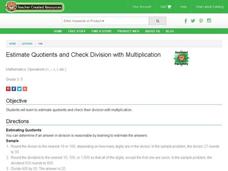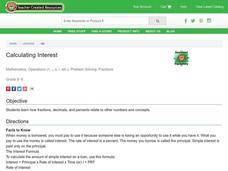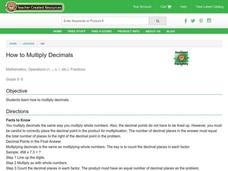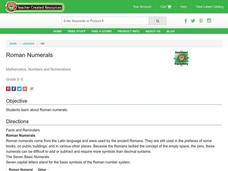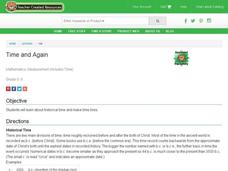Curated OER
Dice Freeze Tag
Students are each given a dice number and then they play a tag game. When tagged, they must add/subtract the number of the person that tagged them to their number, before re-entering the game.
Curated OER
Everybody Needs a Rock
Students, after making quantitative and qualitative observations of their rocks, construct a Venn diagram or dichotomous key to classify their rocks.
Curated OER
Scuba Diving
High schoolers discover that scuba diving is more than a sport. It's a science that operationally integrates physics, chemistry, physiology, and oceanography. They perform a simple experiment which simulates the air tanks used in scuba...
Curated OER
Understanding Computer Images
Ninth graders explain differences between bitmapped images and vector images. They calculate pixels and transpose the raw file size to bits, bytes, and kilobytes. They compare formats for displaying images on a Web page.
Curated OER
Handling Data: Probability, Chase Me game
Young scholars participate in a simulation in which the aim is for the tortoise to catch up with the hare or vice versa. Moves are decided by throwing two dice. Adding together the numbers on the two dice tells you which animal moves...
Curated OER
Immigration in the United States
Pupils examine the reasons why people leave their country to live in another. In groups, they use print and electronic resources to answer questions about where immigrants came from during different time periods and advice given to...
Curated OER
Immigration and American Life Graphing Immigration Data
Young scholars practice graphing immigration data from the Caribbean. After practicing making their own graphs, they make the final graph and label it accordingly. They work together to determine the six most populated states of...
Curated OER
Spatial Relationships: an Over/Under Dance
Students explore the relationships of space through movement. Two perform movement improvisation based on over/under. The activity improves hand-eye coordination, cooperation, and communication skills. The timing of the dance also...
Curated OER
Working Watermelon
You're going to wish you had a watermelon for this lesson! Class members read about watermelons and make a salad in class to sample. They also perform estimates, measurements and calculations on a watermelon. They predict what percentage...
Curated OER
Rainbow Jelly
Pupils work with teaspoons, tablespoons and fractions of a cup to make their own rainbow jelly, converting between units of volume as required. They recognize the need for a standard unit of volume and measure volume using teaspoons and...
Curated OER
Algebra II: Exponential Functions
High schoolers investigate, describe, and predict the effects of parameter changes on the graphs of exponential functions; describe limitations on the domains and ranges of these functions; and examine asymptotic behavior.
Curated OER
Birthdays
Students collect data about the birth months of each classmate using a calendar. They make a table with the information before designing a pictograph using cupcake images. They answer questions using the graph.
Curated OER
Count Coins and Bills
Students study the names and values of different denominations of paper money, count sets of money that include both coins and bills. They complete a money chart, read and solve word problems.
Curated OER
Fact Families
Students explore about fact families. Before students begin doing word problems, they complete an activity . Students explore what a fact family is. A fact family is a set of math problems that use the same three numbers.
Curated OER
Calculating Discounts and Sales
Students discover that a discount is used by manufacturers and merchants to mean taking off a certain percentage of the price given in a price list. This price is called the list price. The list price less the discount is known as the...
Curated OER
Estimate Quotients and Check Division With Multiplication
Students explore how to estimate quotients and check their division with multiplication. They practice rounding the divisor and the dividend. Students compare the estimate to the exact answer and determine if it is reasonable.
Curated OER
Sequences and Exponents
Students practice multiplication sequences and multiplying with exponents. They study how a sequence is a set of numbers which follows a mathematical rule and can be used with all four operations and with combinations of operations.
Curated OER
Calculating Interest
Students explore the concept that when money is borrowed, people pay to use it because someone else is losing an opportunity to use it while they have it. What you pay to use the money is called interest. The rate of interest is a...
Curated OER
Commutative Property and Associative Property
Students observe and complete various math problems involving the commutative and associative properties of multiplication. They observe the teacher solve examples of each property, and complete two worksheets.
Curated OER
Mighty Multiples
Students study about multiples, common multiples, least common multiples, and lowest common denominators. They recognize that a multiple is the product resulting when two or more factors are multiplied by each other and that common...
Curated OER
Multiplying Decimals
Students examine how to multiply decimals. The teacher goes through the lecture telling the students how exactly the answer the problems correctly. The lesson discusses how to use the zero as a placeholder and how to multiply decimals by...
Curated OER
Numerical Palindromes
Students are introduced to the way palindromes have the unusual quality of being the same when read from left to right as when they are read from right to left. They are challenged to generate numerical palindromes and find other ways...
Curated OER
Roman Numerals
Students explore the concept of Roman numerals. They investigate the seven basic numerals and the symbols that are used in the Roman numeral system and their values. Students practice converting Roman numerals.
Curated OER
Time and Again
Young scholars examine historical time and make time lines. They study the two main divisions of time; the time before and after the birth of Christ. They also note that time lines are a way of illustrating the length of historical time.

















